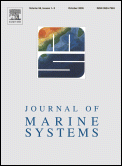
N.E. Martins and S.M. Jesus nmartins@ualg.pt sjesus@ualg.pt
SiPLAB - FCT, Universidade do Algarve,
Campus de Gambelas,
PT-8005-139 Faro, Portugal.
Comments: download pdf
file.
Ref.: submitted to J. of Marine Systems.
Abstract
The prediction of the transmission loss evolution on a day to week frame, in a given
oceanic area, is an important issue in modeling the sonar performance. It relies
primarily on acoustic propagation models, which convert water column and geometric/geoacoustic parameters to 'instantaneous' acoustic field estimates. In practice, to model the acoustic field, even the most accurate acoustic models have to be fed with simplified environmental descriptions, due to computational issues and to a limited knowledge of the environment. This is a limitation, for example, in acoustic inversion methods, in which, by maximizing the proximity between measured and modeled acoustic signals, the estimated environmental parameters are deviated from reality, forming what is normally called an 'acoustically equivalent environment'. This problem arises also in standard acoustic prediction, in which, the oceanographic forecasts and bottom data (typically from archives) are fed directly to an acoustic model. The claim in the present work is that, by converting the oceanographic prediction and the bottom properties to 'acoustically equivalent' counterparts, the acoustic prediction can be obtained in an optimal way, adapted to the environmental model at hand. Here, acoustic prediction is formulated as a Bayesian estimation problem, in which, the observables are oceanographic forecasts, a set of known bottom parameters, a set of acoustic data, and a set of water column data. The predictive posterior PDF of the future acoustic signal is written as a function of elementary PDF functions relating these observables and 'acoustically equivalent' environmental parameters. The latter are obtained by inversion of acoustic data. The concept is tested on simulated data based on water column measurements and forecasts for the MREA' 03 sea trial.
Acknowledgement: this work was supported under POSI, POCTI and POCI programs, and scholarship no. SFRH/BD/9032/2002, from FCT (Portugal).